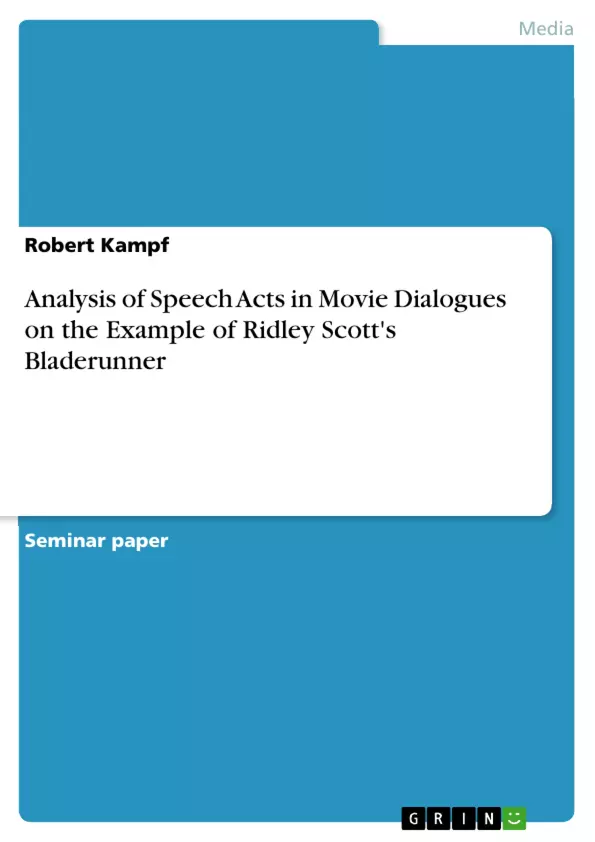This survey will show that stylistic theories, especially the analysis of dialogues in terms of speech acts, turn taking and politeness, can be applied to movies. The intention is to show that these theories, previously applied to literature, enable us to access a complete new level of movie analysis. Language and narrative features in movies are similar to the features in written fiction like novels and can be valued under same criteria. The analysis will focus on two interrogation scenes using the effect of speech acts combined with performance features in order to create a realistic picture of the Replicant itself. This fictional artificial lifeform has a decisive role in the plot of “Bladerunner”, for the difference between humans and Replicants can only be made out from deviations in language, gesture and reactions. These criteria will be looked at in reference to Mick Short’s and Michael Toolan’s basic stylistic theories. The primary objective is to reconstruct the way Scott uses language to outline the characteristics of Replicants from human behavior. Another ambition is to reconstruct the development of realism in sci-fi, in respect of the given criteria, and to show that it has increased over the last decades.
Inhaltsverzeichnis (Table of Contents)
- Introduction
- Basic objectives
- A short introduction to sci-fi
- The world of Bladerunner
- Language
- Analysis and interpretation of Interrogation scene 1: Holden - Leon
- Analysis and interpretation of Interrogation scene 2: Deckard - Rachael
- Comparative Interpretation
- Concluding thoughts
- Appendix
Zielsetzung und Themenschwerpunkte (Objectives and Key Themes)
This survey aims to demonstrate the applicability of stylistic theories, particularly the analysis of dialogues in terms of speech acts, turn-taking, and politeness, to cinematic works. The goal is to show that these theories, previously applied to literature, allow for a deeper level of movie analysis. The analysis focuses on two interrogation scenes, using the effect of speech acts combined with performance features to create a realistic portrayal of the Replicant. The study highlights the significance of language, gesture, and reactions in distinguishing Replicants from humans in the plot of "Bladerunner."
- The application of stylistic theories, particularly speech act analysis, to cinematic dialogues
- The exploration of how language and performance features contribute to the portrayal of Replicants in "Bladerunner"
- The analysis of interrogation scenes to understand the differences between human and Replicant behavior
- The reconstruction of Ridley Scott's use of language to depict the characteristics of Replicants
- The examination of the evolution of realism in science fiction cinema
Zusammenfassung der Kapitel (Chapter Summaries)
The introduction lays out the basic objectives of the study, outlining the analysis of dialogue in terms of speech acts to uncover the character of Replicants in "Bladerunner." It introduces the context of science fiction cinema and highlights the development of the genre from early silent films featuring artificial lifeforms to the more complex, nuanced narratives of later works.
The chapter on language delves into the analysis of two interrogation scenes, examining the speech acts and performance features that distinguish between human and Replicant characters. These analyses offer insights into the characterizations of the protagonists and their interactions.
The chapter on comparative interpretation likely draws connections between the findings from the language analysis and broader themes and concepts within the film. It might explore how these findings contribute to the overall narrative and thematic implications of "Bladerunner."
Schlüsselwörter (Keywords)
The main keywords and focus topics of this text revolve around the analysis of speech acts, turn-taking, and politeness in cinematic dialogues. It explores the portrayal of Replicants in "Bladerunner" using these theoretical frameworks, highlighting the importance of language, gesture, and reactions in defining the characters' humanity. The study further examines the evolution of realism in science fiction cinema, particularly in relation to the depiction of artificial intelligence and its implications for human society.
- Quote paper
- Robert Kampf (Author), 2004, Analysis of Speech Acts in Movie Dialogues on the Example of Ridley Scott's Bladerunner, Munich, GRIN Verlag, https://www.grin.com/document/149456



